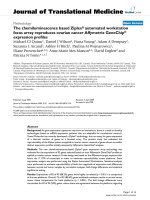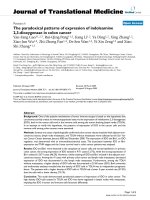báo cáo hóa học: "The exoskeletons are here" potx
Bạn đang xem bản rút gọn của tài liệu. Xem và tải ngay bản đầy đủ của tài liệu tại đây (188.04 KB, 3 trang )
BioMed Central
Page 1 of 3
(page number not for citation purposes)
Journal of NeuroEngineering and
Rehabilitation
Open Access
Commentary
The exoskeletons are here
Daniel P Ferris
1,2,3
Address:
1
School of Kinesiology, University of Michigan, Ann Arbor, MI, USA,
2
Department of Biomedical Engineering, University of Michigan,
Ann Arbor, MI, USA and
3
Department of Physical Medicine and Rehabilitation, University of Michigan, Ann Arbor, MI, USA
Email: Daniel P Ferris -
Abstract
It is a fantastic time for the field of robotic exoskeletons. Recent advances in actuators, sensors,
materials, batteries, and computer processors have given new hope to creating the exoskeletons
of yesteryear's science fiction. While the most common goal of an exoskeleton is to provide
superhuman strength or endurance, scientists and engineers around the world are building
exoskeletons with a wide range of diverse purposes. Exoskeletons can help patients with
neurological disabilities improve their motor performance by providing task specific practice.
Exoskeletons can help physiologists better understand how the human body works by providing a
novel experimental perturbation. Exoskeletons can even help power mobile phones, music players,
and other portable electronic devices by siphoning mechanical work performed during human
locomotion. This special thematic series on robotic lower limb exoskeletons and orthoses includes
eight papers presenting novel contributions to the field. The collective message of the papers is that
robotic exoskeletons will contribute in many ways to the future benefit of humankind, and that
future is not that distant.
Introduction
In 2004, Rodney Brooks, then director of the Massachu-
setts Institute of Technology Computer Science and Artifi-
cial Intelligence Laboratory and general robot guru,
proclaimed that "the robots are here" [1]. He made the
case that robots had infiltrated our homes and everyday
lives to the extent that it was no longer appropriate to say
"the robots are coming". Brooks also went on to state that,
in his opinion, robots in 2004 were where personal com-
puters were in 1978. That is, they were both located just
before the exponential expansion of their ubiquitous
deployment throughout our civilization. Brooks predicted
that in 15 years (i.e. 2019), robots would be everywhere,
just as personal computers were everywhere in 1993 [1].
Adding a corollary onto Brooks' prediction, I firmly
believe that robotic exoskeletons are today where comput-
ers were in 1978. Currently, popular media outlets rou-
tinely herald new robotic exoskeletons such as HAL,
BLEEX, and XOS [2]. Even more recently, Honda has
come out with variations, their Stride Management Assist
and their Bodyweight Support Assist [3]. By 2024, people
will be walking down the street, in the malls, and to their
homes wearing robotic exoskeletons. They will make it
easier for people to carry backpacks and walk for a long
duration, and they will be portable, svelte, and fashiona-
ble. Rehabilitation clinics will have an assortment of
exoskeletons available to aid patients that have experi-
enced spinal cord injury, stroke, and other neurological
disorders. There will be some models designed for assis-
tive technology such that the patients will wear them any-
time they walk, and there will be some models designed
for rehabilitation such that they will be used for motor re-
training in the clinic. There will also be various exoskele-
Published: 9 June 2009
Journal of NeuroEngineering and Rehabilitation 2009, 6:17 doi:10.1186/1743-0003-6-17
Received: 20 April 2009
Accepted: 9 June 2009
This article is available from: />© 2009 Ferris; licensee BioMed Central Ltd.
This is an Open Access article distributed under the terms of the Creative Commons Attribution License ( />),
which permits unrestricted use, distribution, and reproduction in any medium, provided the original work is properly cited.
Journal of NeuroEngineering and Rehabilitation 2009, 6:17 />Page 2 of 3
(page number not for citation purposes)
tons available that do not add mechanical power to the
wearer, but harvest energy from the walking motion to
power mobile phones and other portable electronic
devices.
Exoskeleton development has an advantage over robot
development in general because exoskeletons can rely on
the intelligence of the human user. Exoskeletons can take
advantage of all the sensors, computational power, con-
trol system, and mechanics that humans possess. As a
result, the types of controllers that need to be created for
exoskeletons are quite different from the types of control-
lers that need to be created for autonomous independent
robots.
Exoskeleton development also has a disadvantage over
general robot development in that exoskeletons have to
work in cooperation with the physiology and biomechan-
ics of the human body. This is a major disadvantage
because there is a great deal not understood about the
physiology and biomechanics of human movement [4]. If
it isn't clear how the metabolic cost of walking is deter-
mined by the biomechanical pattern of gait, how is it pos-
sible to predict how mechanical assistance will reduce
locomotion energetics? If principles governing motor
learning during human locomotion are not identified,
how can engineers optimize the control algorithms of the
exoskeletons? While this disadvantage clearly presents a
roadblock to creating useful robotic exoskeletons, there is
hope in that studying humans walking with robotic
exoskeletons can provide important new insight into
human physiology and biomechanics that wasn't previ-
ously accessible [4-14].
Thematic series
In this special thematic series, eight papers contribute new
advances on robotic exoskeleton technology and our
understanding of how humans respond to mechanical
assistance from robotic exoskeletons. Herr starts off with
a review on exoskeletons and orthoses, highlighting major
accomplishments and discussing future directions in the
field [15]. Herr is more conservative than I have been in
my prediction of widespread exoskeleton use, as he states
it is hopeful that exoskeletons will be in common use by
the end of the 21
st
century. In a second review in the the-
matic series, Crespo and Reinkensmeyer focus on control
strategies that have been used for robotic movement train-
ing after neurological injury [16]. The control strategies
used for rehabilitation exoskeletons are likely to have a
large impact on their success, so this is an area of research
that needs substantial effort in the future. Staying in the
broader area of rehabilitation exoskeletons, Mankala et al.
present a novel exoskeleton design for gait training [17],
and Westlake and Patten communicate results from a
pilot study on gait training after stroke [18]. In the area of
exoskeletons for studying human movement physiology,
Sawicki describes a robotic knee-ankle-foot orthosis
under proportional myoelectric control [19], and Noel et
al. provide some interesting results on adaptation to
mechanical forces from a robotic ankle orthosis [20]. The
thematic series ends with two excellent contributions on
energy harvesting exoskeletons. The first transmits nega-
tive mechanical work at the knee into electrical energy
[21], and the second uses pneumatics to store energy dur-
ing stance for powering dorsiflexor assistance during
swing [22].
Conclusion
To advance exoskeleton technology at the fastest rate pos-
sible, it is critical that scientists and engineers document
and share their successes and failures with the research
community. This special thematic series is intended to
highlight that need. A major factor limiting the develop-
ment of powered prostheses in the past has been the lack
of carefully controlled scientific studies and open publica-
tion of technological advancements. While it is under-
standable that for-profit companies do not readily
publish their research and development work, researchers
at universities and institutes need to focus more on how
they can move the field forward in cooperation with for-
profit companies. University and institute researchers can
identify basic principles governing human movement
with robotic technologies (exoskeletons, prostheses, etc.)
with carefully designed experimental studies. They can
also provide unbiased assessment of new technologies
with controlled tests using adequate sample sizes. Lastly,
they can reach out to for-profit companies working on
research and development to offer their services and
expertise in mutually beneficial collaborations. While the
collaboration work may still not yield peer-reviewed pub-
lications, it does provide opportunities for scientists and
engineers to learn from each other in a way that would
greatly benefit the field.
References
1. Brooks RA: The robots are here. Technology Review 2004, 107:30.
2. Mone G: Building the real Iron Man. Popular Science 2008 [http:/
/www.popsci.com/node/20689].
3. Honda: 2009 [ />].
4. Ferris DP, Sawicki GS, Daley MA: A physiologist's perspective on
robotic exoskeletons for human locomotion. International Jour-
nal of Humanoid Robotics 2007, 4:507-528.
5. Sawicki GS, Ferris DP: Mechanics and energetics of level walk-
ing with powered ankle exoskeletons. Journal of Experimental
Biology 2008, 211:1402-1413.
6. Sawicki GS, Ferris DP: Mechanics and energetics of incline walk-
ing with robotic ankle exoskeletons. Journal of Experimental Biol-
ogy 2009, 212:32-41.
7. Sawicki GS, Ferris DP: Powered ankle exoskeletons reveal the
metabolic cost of plantar flexor mechanical work during
walking with longer steps at constant step frequency. Journal
of Experimental Biology 2009, 212:21-31.
8. Sawicki GS, Lewis CL, Ferris DP: It pays to have a spring in your
step. Exercise and Sport Science Reviews 2009 in press.
9. Gordon KE, Ferris DP: Learning to walk with a robotic ankle
exoskeleton. Journal of Biomechanics 2007, 40:2636-2644.
Publish with BioMed Central and every
scientist can read your work free of charge
"BioMed Central will be the most significant development for
disseminating the results of biomedical research in our lifetime."
Sir Paul Nurse, Cancer Research UK
Your research papers will be:
available free of charge to the entire biomedical community
peer reviewed and published immediately upon acceptance
cited in PubMed and archived on PubMed Central
yours — you keep the copyright
Submit your manuscript here:
/>BioMedcentral
Journal of NeuroEngineering and Rehabilitation 2009, 6:17 />Page 3 of 3
(page number not for citation purposes)
10. Cain SM, Gordon KE, Ferris DP: Locomotor adaptation to a
powered ankle-foot orthosis depends on control method.
Journal of Neuroengineering and Rehabilitation 2007, 4:48.
11. Kinnaird CR, Ferris DP: Medial gastrocnemius myoelectric con-
trol of a robotic ankle exoskeleton. IEEE Transactions on Neural
Systems and Rehabilitation Engineering 2009, 17:31-37.
12. Lam T, Anderschitz M, Dietz V: Contribution of feedback and
feedforward strategies to locomotor adaptations. Journal of
Neurophysiology 2006, 95:766-773.
13. Lam T, Wirz M, Lunenburger L, Dietz V: Swing phase resistance
enhances flexor muscle activity during treadmill locomotion
in incomplete spinal cord injury. Neurorehabilitation and Neural
Repair 2008, 22:438-446.
14. Gordon KE, Wu M, Kahn JH, Dhaher YY, Schmit BD: Ankle load
modulates hip kinetics and EMG during human locomotion.
Journal of Neurophysiology 2009, 101:2062-2076.
15. Herr H: Exoskeletons and orthoses: classification, design
challenges and future directions. Journal of Neuroengineering and
Rehabilitation 2009 in press.
16. Crespo LM, Reinkensmeyer DJ: Review of control strategies for
robotic movement training after neurologic injury. Journal of
Neuroengineering and Rehabilitation 2009 in press.
17. Mankala KK, Banala SK, Agrawal SK: Novel swing-assist un-
motorized exoskeletons for gait training. Journal of Neuroengi-
neering and Rehabilitation 2009 in press.
18. Westlake KP, Patten C: Pilot study of lokomat versus manual-
assisted treadmill training for locomotor recovery post-
stroke. J Neuroeng Rehabil 2009, 6(1):18.
19. Sawicki GS, Ferris DP: A pneumatically powered knee-ankle-
foot orthosis (KAFO) with myoelectric activation and inhibi-
tion. Journal of Neuroengineering and Rehabilitation 2009 in press.
20. Noel M, Fortin K, Bouyer LG: Using an electrohydraulic ankle
foot orthosis to study feedforward/feedback control strate-
gies during locomotor adaptation to force fields applied in
stance. Journal of Neuroengineering and Rehabilitation 2009 in press.
21. Li Q, Naing V, Donelan JM: Development of a biomechanical
energy harvester. Journal of Neuroengineering and Rehabilitation
2009 in press.
22. Chin R, Hsiao-Wecksler ET, Loth E, Kogler G, Manwaring SD, Tyson
SN, Shorter KA, Gilmer JN: A pneumatic power harvesting
ankle-foot orthosis to prevent foot-drop. Journal of Neuroengi-
neering and Rehabilitation 2009 in press.









